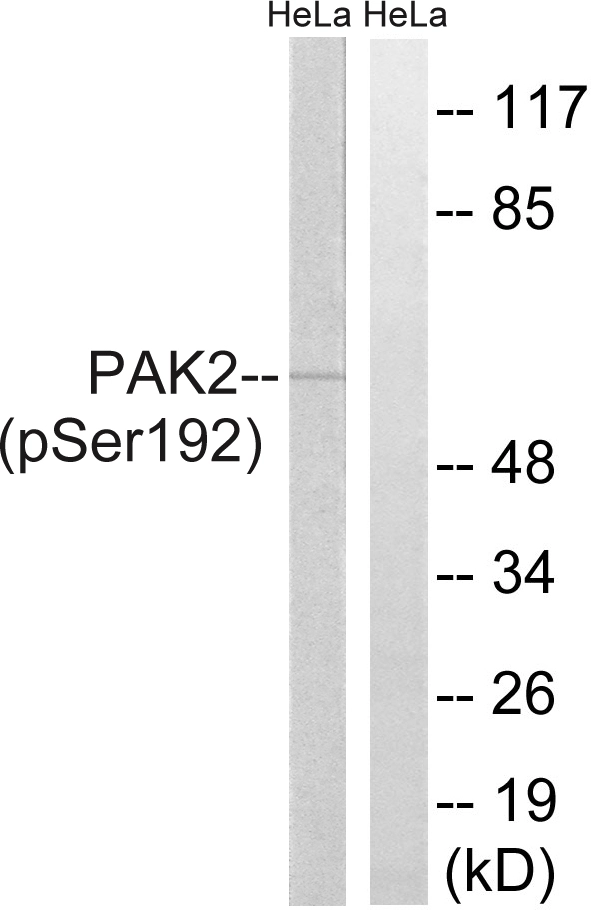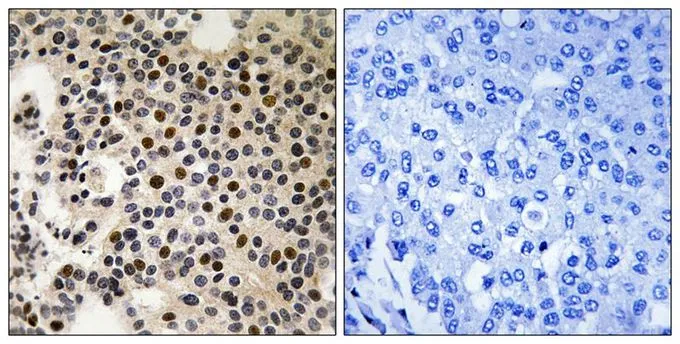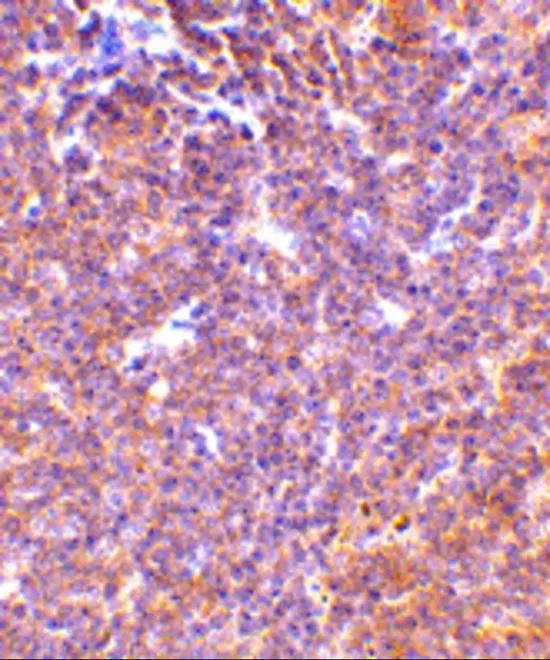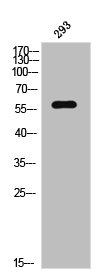![ICC/IF analysis of C6 cells using GTX02856 PAK2 antibody [GT1259]. Dilution : 1:100 Blue : DAPI for nuclear staining. ICC/IF analysis of C6 cells using GTX02856 PAK2 antibody [GT1259]. Dilution : 1:100 Blue : DAPI for nuclear staining.](https://www.genetex.com/upload/website/prouct_img/normal/GTX02856/A4553_IF_01_(1076030)_w_23053123_844.webp)
ICC/IF analysis of C6 cells using GTX02856 PAK2 antibody [GT1259]. Dilution : 1:100 Blue : DAPI for nuclear staining.
PAK2 antibody [GT1259]
GTX02856
ApplicationsImmunoFluorescence, Western Blot, ImmunoCytoChemistry
Product group Antibodies
TargetPAK2
Overview
- SupplierGeneTex
- Product NamePAK2 antibody [GT1259]
- Delivery Days Customer9
- Application Supplier NoteWB: 1:500 - 1:2000. ICC/IF: 1:50 - 1:200. *Optimal dilutions/concentrations should be determined by the researcher.Not tested in other applications.
- ApplicationsImmunoFluorescence, Western Blot, ImmunoCytoChemistry
- CertificationResearch Use Only
- ClonalityMonoclonal
- Clone IDGT1259
- Concentration0.53 mg/ml
- ConjugateUnconjugated
- Gene ID5062
- Target namePAK2
- Target descriptionp21 (RAC1) activated kinase 2
- Target synonymsgamma-PAK; p21 (CDKN1A)-activated kinase 2; p21 protein (Cdc42/Rac)-activated kinase 2; p21-activated kinase 2; p58; PAK-2; PAK65; PAKgamma; S6/H4 kinase; serine/threonine-protein kinase PAK 2
- HostRabbit
- IsotypeIgG
- Protein IDQ13177
- Protein NameSerine/threonine-protein kinase PAK 2
- Scientific DescriptionThe p21 activated kinases (PAK) are critical effectors that link Rho GTPases to cytoskeleton reorganization and nuclear signaling. The PAK proteins are a family of serine/threonine kinases that serve as targets for the small GTP binding proteins, CDC42 and RAC1, and have been implicated in a wide range of biological activities. The protein encoded by this gene is activated by proteolytic cleavage during caspase-mediated apoptosis, and may play a role in regulating the apoptotic events in the dying cell. [provided by RefSeq, Jul 2008]
- Storage Instruction-20°C,2°C to 8°C
- UNSPSC12352203

![ICC/IF analysis of NIH-3T3 cells using GTX02856 PAK2 antibody [GT1259]. Dilution : 1:100 Blue : DAPI for nuclear staining. ICC/IF analysis of NIH-3T3 cells using GTX02856 PAK2 antibody [GT1259]. Dilution : 1:100 Blue : DAPI for nuclear staining.](https://www.genetex.com/upload/website/prouct_img/normal/GTX02856/A4553_IF_02_(1076031)_w_23053123_624.webp)
![ICC/IF analysis of U2OS cells using GTX02856 PAK2 antibody [GT1259]. Dilution : 1:100 Blue : DAPI for nuclear staining. ICC/IF analysis of U2OS cells using GTX02856 PAK2 antibody [GT1259]. Dilution : 1:100 Blue : DAPI for nuclear staining.](https://www.genetex.com/upload/website/prouct_img/normal/GTX02856/A4553_IF_03_(1076032)_w_23053123_526.webp)
![WB analysis of various samples using GTX02856 PAK2 antibody [GT1259]. Dilution : 1:1000 Loading : 25microg WB analysis of various samples using GTX02856 PAK2 antibody [GT1259]. Dilution : 1:1000 Loading : 25microg](https://www.genetex.com/upload/website/prouct_img/normal/GTX02856/CutImage_A4553_WB_01_(1070464)_w_23053123_461.webp)
![Various whole cell extracts (30 microg) were separated by 10% SDS-PAGE, and the membrane was blotted with PAK2 antibody [GT1259] (GTX02856) diluted at 1:1000. The HRP-conjugated anti-rabbit IgG antibody (GTX213110-01) was used to detect the primary antibody. Various whole cell extracts (30 microg) were separated by 10% SDS-PAGE, and the membrane was blotted with PAK2 antibody [GT1259] (GTX02856) diluted at 1:1000. The HRP-conjugated anti-rabbit IgG antibody (GTX213110-01) was used to detect the primary antibody.](https://www.genetex.com/upload/website/prouct_img/normal/GTX02856/GTX02856_4000001030_20210122_WB_2_w_23053123_481.webp)
![Various whole cell extracts (30 microg) were separated by 10% SDS-PAGE, and the membrane was blotted with PAK2 antibody [GT1259] (GTX02856) diluted at 1:1000. The HRP-conjugated anti-rabbit IgG antibody (GTX213110-01) was used to detect the primary antibody. Various whole cell extracts (30 microg) were separated by 10% SDS-PAGE, and the membrane was blotted with PAK2 antibody [GT1259] (GTX02856) diluted at 1:1000. The HRP-conjugated anti-rabbit IgG antibody (GTX213110-01) was used to detect the primary antibody.](https://www.genetex.com/upload/website/prouct_img/normal/GTX02856/GTX02856_4000001030_20210122_WB_w_23053123_806.webp)






